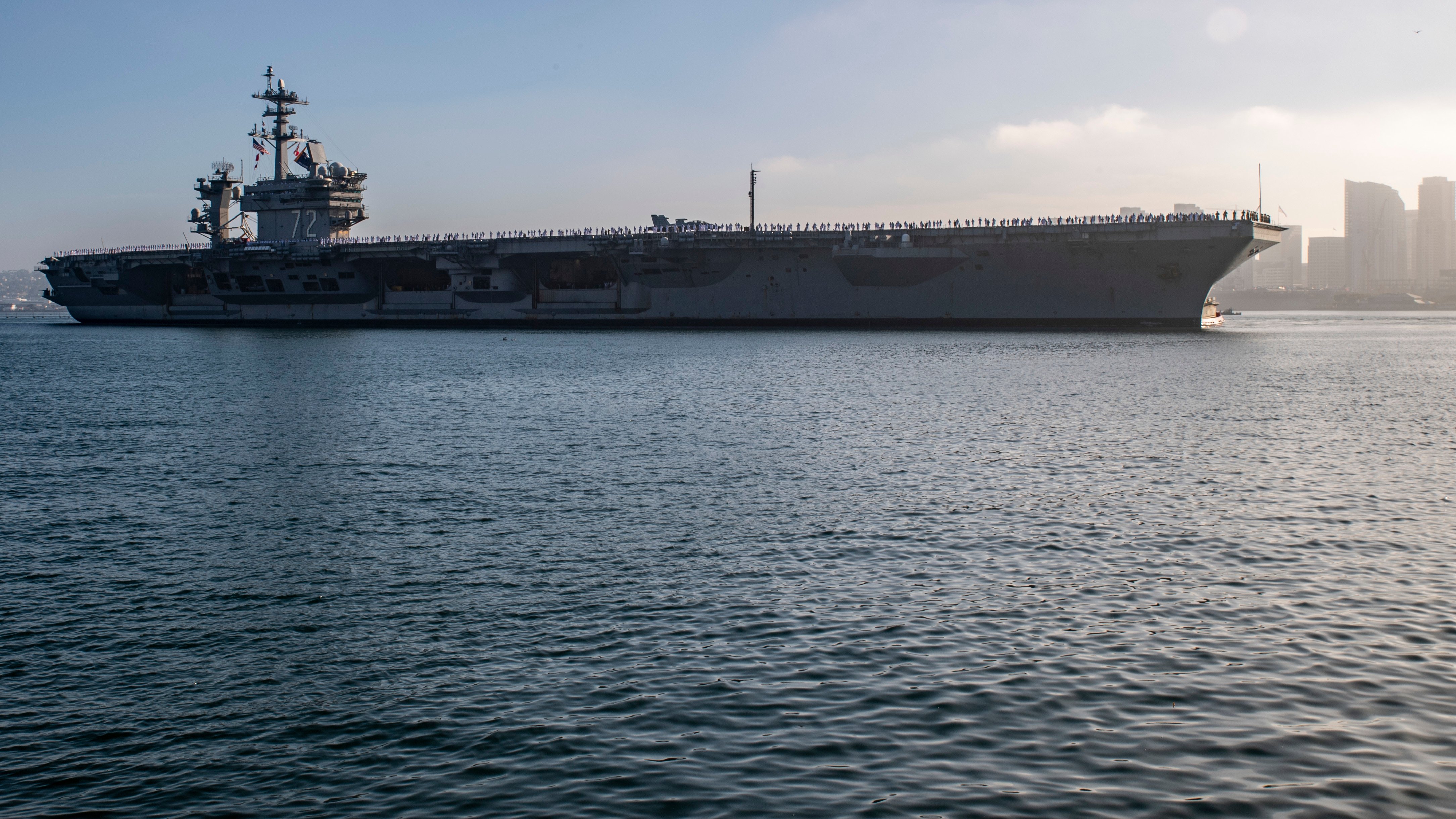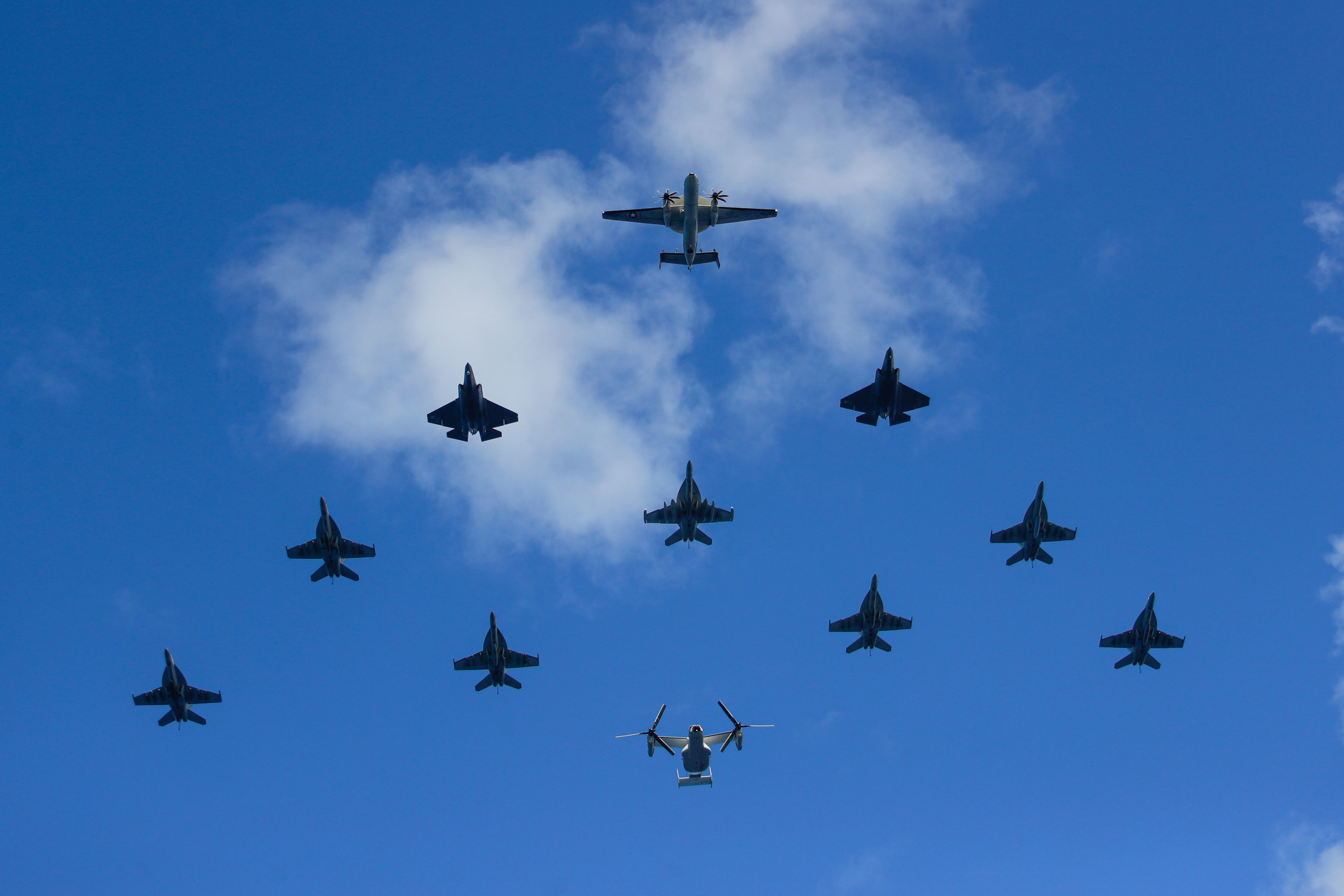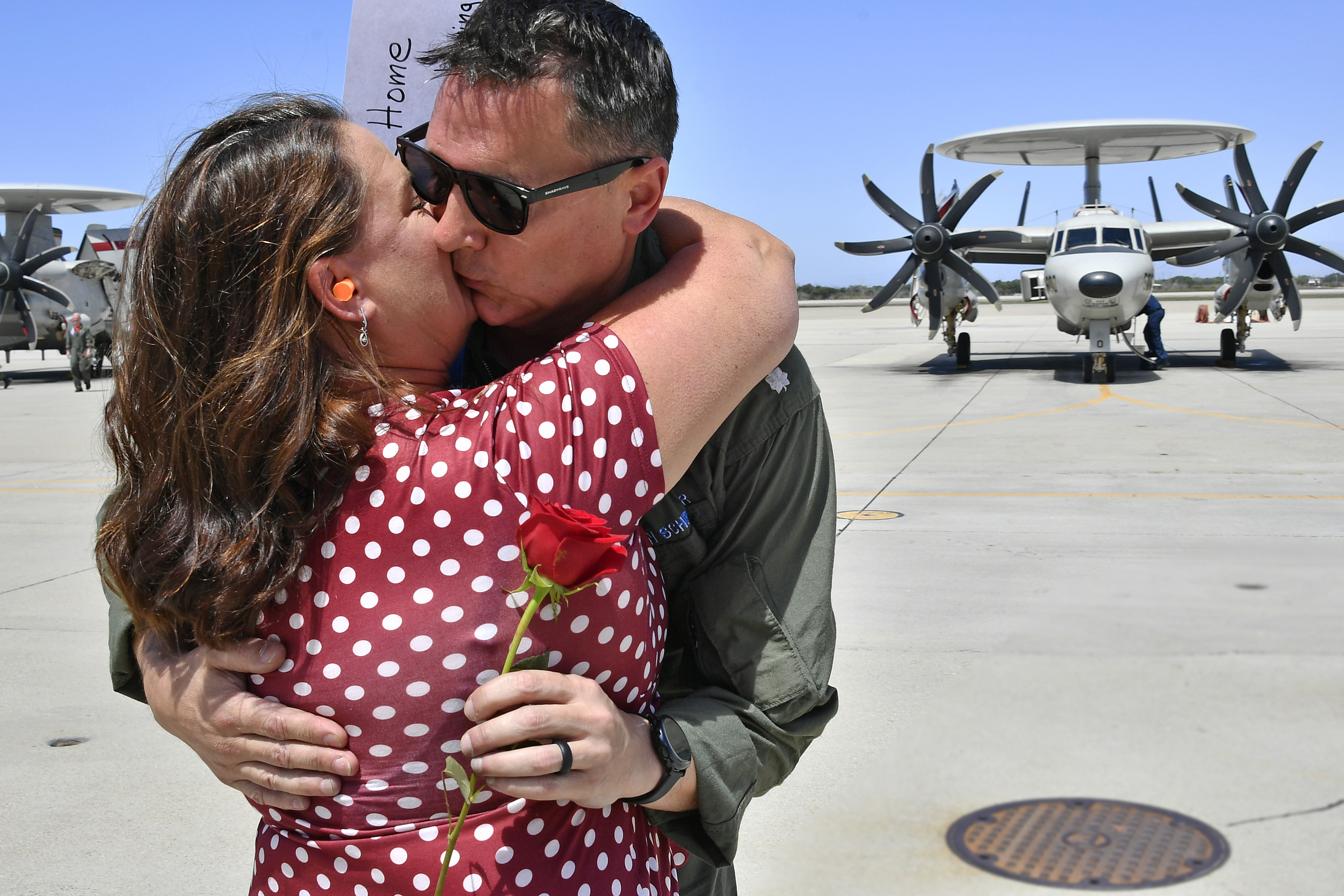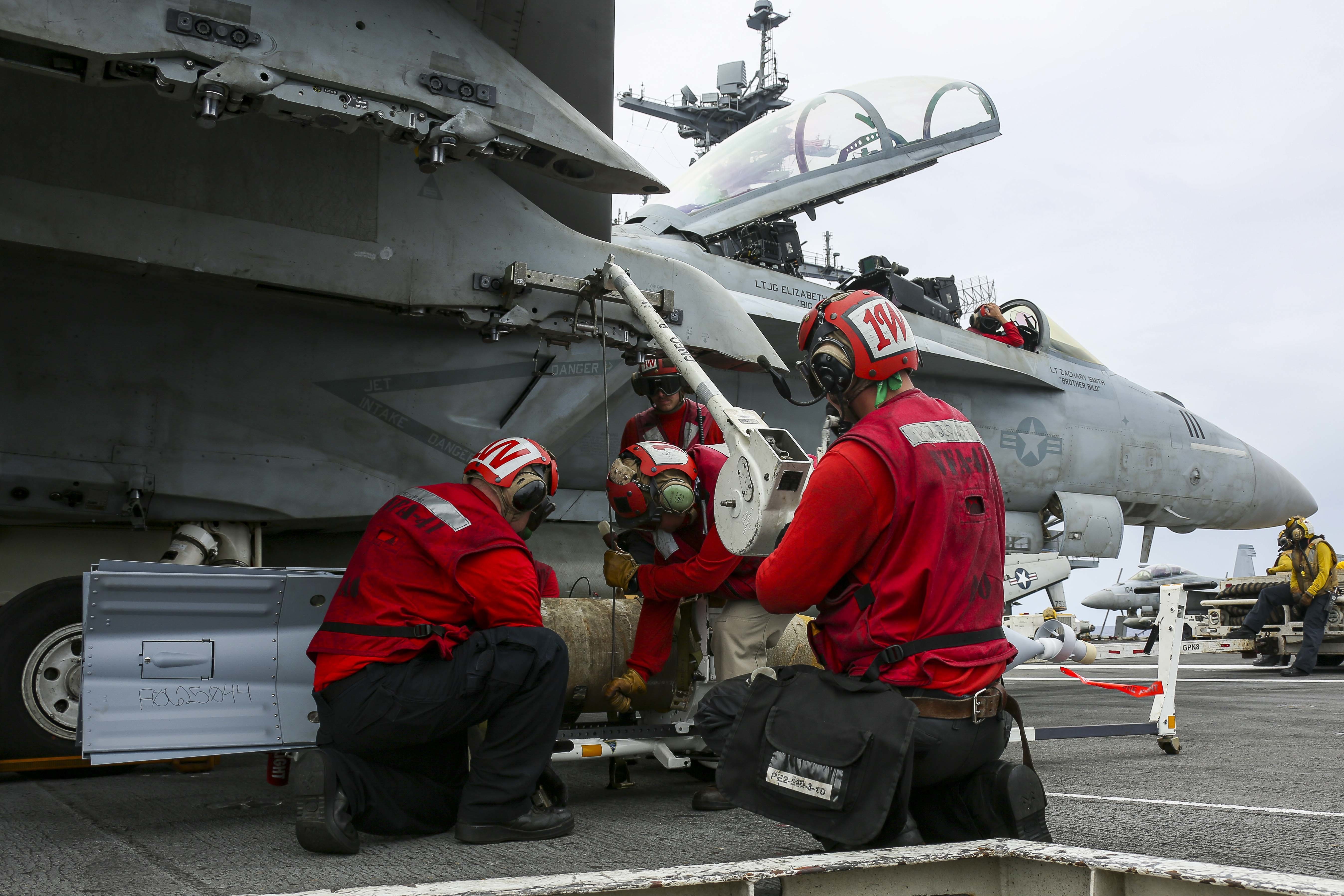
USS Abraham Lincoln (CVN-72) and most of its strike group returned home this week, ending an Indo-Pacific deployment that crossed some 62,000 miles across the Pacific and was the first to set sail with the Marine Corps’ F-35C Lightning II Joint Strike Fighter fifth-generation jet.
The Nimitz-class carrier pulled into its Coronado, Calif., berth at Naval Air Station North Island Thursday morning, two days after most of its Carrier Air Wing 9 squadrons flew their jets and helicopters off the flight deck to their respective home air stations.
Four of the Destroyer Squadron 21 ships in the strike group also returned to their home ports. Guided-missile cruiser USS Mobile Bay (CG-53) and guided-missile destroyer USS Spruance (DDG-111) went home to Naval Base San Diego, Calif., and destroyers USS Gridley (DDG-101) and USS Sampson (DDG-102) sailed to Naval Station Everett, Wash. Another ship, destroyer USS Fitzgerald (DDG-62), will return home to San Diego at a later date, U.S. 3rd Fleet officials said.
“Over the past seven months, the Abraham Lincoln Carrier Strike Group served as a flexible and dynamic response option and demonstrated its commitment to partners and allies in the Indo-Pacific region,” Rear Adm. J.T. Anderson, Carrier Strike Group 3 commander, said in a 3rd Fleet news release. “Our strike group conducted a myriad of joint and combined missions and exercises. Throughout the Indo-Pacific, it is clear how significant our relationships are with our allies and partners and how impactful every single Abraham Lincoln Carrier Strike Group sailor and Marine has been since we departed in January.”
With 4,862 sailors and Marines embarked, Lincoln spent five of its seven-month deployment in U.S. 7th Fleet, providing the Japan-based command with an additional carrier presence at times during exercises in the region with partners including Japan. That included dual-carrier operations around the Philippines and in the South China Sea earlier this year.
Those missions “demonstrated to countries in the region that we support them and their international rights,” Lincoln‘s skipper, Capt. Amy Bauernschmidt, said during a media call Wednesday as the carrier headed to San Diego. The crew “directly contributed to the preservation of the freedom of navigation and free flow of commerce in the region. What they did matters, and their hard work made the difference in the region and for our nation.”

While in the South China Sea, ships with the People’s Liberation Army Navy ships trailed nearby at times, shadowing the U.S. carrier in what is a regular occurrence, Bauernschmidt, the first woman to command a U.S. aircraft carrier, said.
“We were operating in the vicinity [of] Chinese warships at times, mostly … that shadowed our ship,” she said, noting, “It was safe and professional the entire time that we interacted with them. During some flight operations, our aircraft did interact with some of their aircraft, but again it remained safe and professional each and every time we interacted with them.”
Those interactions with PLAN ships happened during regular operations and exercises, as Lincoln didn’t conduct any freedom of navigation operations, she added. Other U.S. Navy ships have done FONOPs in the region as a recurring reminder to China that the U.S. and allies support a free and open Indo-Pacific region.
Lincoln‘s air wing kept busy during the 222-day deployment, tallying 26,919 flight hours, 8,515 catapult shots and a similar number of arrested-landings, Bauernschmidt said.
The air wing included the “Black Knights” of Marine Strike Fighter Squadron (VMFA) 314, an F-35C squadron based at Marine Corps Air Station Miramar in San Diego and the first to deploy overseas with a carrier. They operated with 10 of the fixed-wing Joint Strike Fighters.
The wing also marked the second carrier deployment for a Navy CMV-22 Osprey squadron. That mission was done by the “Titans” of North Island-based Fleet Logistics Multi-Mission Squadron (VRM) 30.
“We were able to operate with them seamlessly,” Bauernschmidt said of the F-35Cs, noting that “the situational awareness that they are able to provide commanders onboard the aircraft carrier is second to none.”
“Their ability to collect, analyze and share data was pretty unmatched by other aircraft,” she added.

The Marine F-35C squadron joined other CVW-9 squadrons returning home this week from Lincoln: Navy Fighter Attack Squadrons (VFA) 41, VFA-151 and VFA-14, based at Naval Air Station Lemoore, Calif.; Electronic Attack Squadron (VAQ) 133 based at NAS Whidbey Island, Wash.; Airborne Early Warning Squadron (VAW) 117 based at NAS Point Mugu, Calif.; and Helicopter Sea Combat Squadron (HSC) 14 and Helicopter Maritime Strike Squadron (HSM) 71 based at North Island.
“Carrier Air Wing 9 Sailors and Marines worked together over the last seven months, providing a credible deterrent to any potential adversary in the Pacific,” CVW-9 commander Capt. Lew Callaway said in the release. “Naval aviators culminated 100 years of aircraft carrier aviation history operating 4th- and 5th-generation aircraft from a Nimitz-class aircraft carrier at sea. We are grateful for the chance to serve, and celebrate our return to home port, family, and friends.”
Lincoln last week hosted the closing reception for Rim of the Pacific 2022, held off Hawaii and Southern California, and involving the navies and maritime forces of 26 countries. Integration with other forces “is critical,” Bauernschmidt said. “ A lot of the operations that we conducted as part of the task force that was there operating were the same things that we did on deployment.”
While DESRON 21, embarked on the carrier, served as the sea combat commander during the deployment, for RIMPAC that role was filled by an O-6 captain with the New Zealand Navy. That officer “performed exceptionally well in terms of doing the anti-surface and anti-submarine warfare (missions),” she said. “We also had a South Korean warship that took over duties as the air defense commander quite a few times and did exceptionally well.”

The crawl-walk-run approach, she noted, helped integrate the various forces that joined in the large, multinational maritime exercise. “It really was incredible to work with so many warships and so many sailors and Marines from so many different countries. It really was exactly as they described, a joint and combined maritime exercise.”
During RIMPAC, the ships making up the Lincoln CSG “did everything from strait transits in air defense exercises to supporting humanitarian assistance and disaster relief and so many operations,” she added. “We really concentrated on everyone’s national objective, in order to try to build a much stronger force, so that when we are out operating in areas like the 7th Fleet … that integration on deployment is that much more seamless and flawless.”
“While USS Lincoln did not work with other countries, some of the ships in our strike group did, and each time we worked together we were able to build on that foundation, that relationship, that mutual understanding of completing the mission,” she said.





